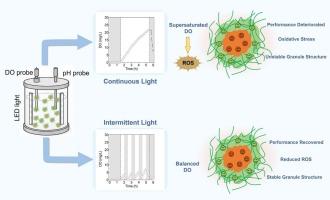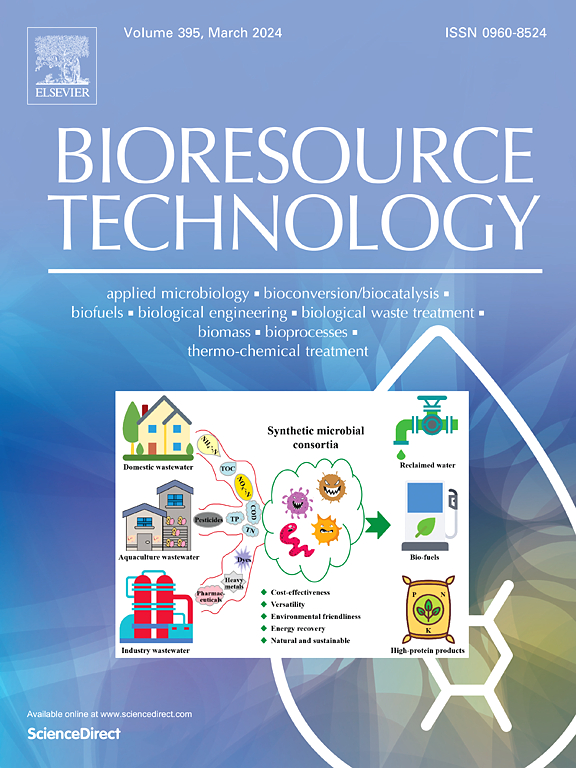Light-driven oxygen supersaturation controls microbial resilience in microalgal-bacterial granular sludge systems: Novel intermittent regulation strategy for carbon–neutral wastewater treatment
IF 9
1区 环境科学与生态学
Q1 AGRICULTURAL ENGINEERING
引用次数: 0
Abstract
Microalgal-bacterial granular sludge (MBGS) enables carbon–neutral wastewater treatment by replacing aeration with photosynthetic oxygen. However, excessive light can induce dissolved oxygen (DO) supersaturation and triggering oxidative stress. This study investigated the effects of lighting mode (continuous vs. intermittent) and light intensity (400 and 800 μmol/m2/s) on MBGS performance over 96 days. At both light intensities, continuous light caused severe DO accumulation (>25 mg O2/L), elevated reactive oxygen species (ROS), and reduced nutrient removal. Intermittent light effectively regulated DO, alleviated ROS stress, enhanced antioxidative enzyme activity, and restored microbial function. Under intermittent light, NH4-N, TN, and PO4-P removal efficiencies reached 99.2 %, 81.5 %, and 94.2 % (400 μmol/m2/s), and 89.7 %, 69.9 %, and 91.5 % (800 μmol/m2/s). Functional genera such as Dechloromonas, Pseudoxanthomonas and Pseudomonas were enriched under intermittent light mode. These results demonstrate that intermittent light is a feasible strategy to mitigate photo-oxygen stress and enhance nutrient removal in aeration-free MBGS systems.

光驱动氧过饱和控制微藻-细菌颗粒污泥系统中的微生物弹性:碳中性废水处理的新型间歇调节策略
微藻-细菌颗粒污泥(MBGS)通过用光合氧气代替曝气,实现碳中性废水处理。然而,过度的光照会导致溶解氧(DO)过饱和并引发氧化应激。研究了连续、间断光照模式和光照强度(400 μmol/m2/s和800 μmol/m2/s)对MBGS性能的影响。在两种光照强度下,连续光照均导致DO积累严重(>25 mg O2/L),活性氧(ROS)增加,营养物质去除减少。间歇性光照可有效调节DO,缓解ROS胁迫,增强抗氧化酶活性,恢复微生物功能。在间歇光条件下,NH4-N、TN和PO4-P的去除率分别为99.2%、81.5%和94.2% (400 μmol/m2/s)和89.7%、69.9%和91.5% (800 μmol/m2/s)。在间歇光照模式下,功能属如脱氯单胞菌、假黄单胞菌和假单胞菌富集。这些结果表明,在无曝气MBGS系统中,间歇性光照是一种缓解光氧胁迫和增强营养物质去除的可行策略。
本文章由计算机程序翻译,如有差异,请以英文原文为准。
求助全文
约1分钟内获得全文
求助全文
来源期刊

Bioresource Technology
工程技术-能源与燃料
CiteScore
20.80
自引率
19.30%
发文量
2013
审稿时长
12 days
期刊介绍:
Bioresource Technology publishes original articles, review articles, case studies, and short communications covering the fundamentals, applications, and management of bioresource technology. The journal seeks to advance and disseminate knowledge across various areas related to biomass, biological waste treatment, bioenergy, biotransformations, bioresource systems analysis, and associated conversion or production technologies.
Topics include:
• Biofuels: liquid and gaseous biofuels production, modeling and economics
• Bioprocesses and bioproducts: biocatalysis and fermentations
• Biomass and feedstocks utilization: bioconversion of agro-industrial residues
• Environmental protection: biological waste treatment
• Thermochemical conversion of biomass: combustion, pyrolysis, gasification, catalysis.
 求助内容:
求助内容: 应助结果提醒方式:
应助结果提醒方式:


